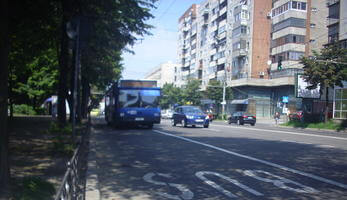Bus priority measures
Thematic areas
Demand & urban space management
Summary
Priority measures for public transport - like green light priority or the conversion of road space to dedicated PT lanes - can contribute to reducing the travel time differences between private cars and public transport and thereby make public transport more attractive and more energy efficient due to a better flow.
Implementing sustainable mobility
Prior to the scheme no special priority had been granted to public transport in Iasi. Road condition communication for public transport was rudimentary, consisting of of an antenna with a signal repeater. The antenna is placed in the city and receives and transmits the information.
The measure is intended to contribute to increasing the quality of Public Transport in Iasi by addressing problems of travel time and reliability, making Public Transport a more attractive and hassle free option. In this measure Iasi will implement a green light priority system within the CIVITAS plus corridor in order to promote a high quality and energy-efficient bus route. Iasi will define priority routes for public transport vehicles - buses and trams (but also open to taxi-cabs) in the CIVITAS corridor and implement a green light priority system in the CIVITAS corridor for public transport vehicles at 15 signalised intersections.
Progress
The priority system has been operational since 2010. ARCHIMEDES contributed to costs for equipment related to signals, planning and monitoring.
Outcomes
Surveys have been carried out among passengers to determine the quality of transport indicators. The results obtained showed that 45% of the passengers are now satisfied with public transport services, with an increase of 9% since 2010, considering them more attractive and more efficient that before the measure was implemented. Accuracy of time keeping indicator has been calculated to see the impact that it has on the fulfillment of public transport vehicles’ proposed time schedule. We noticed that more and more PT vehicles arrived on tine in stations: 78% in 2010 and 88% in 2011. Also, the average vehicle speed has been mathematically determined. Due to especially created public transport lane, the average vehicle speed increased within 2009-2011 having a direct impact on the number of PT vehicles’ arrivals on time. Average speed of bus in peak hours has improved in a 5,93% (15,90 km/h) and in off peak hours in a 7,78% (19,40%). The objetive of 10% has not been reached cmpletely, but the results have been affected by tramway works with impact in the current bus operation. This construction works create a temporary influence on the measure’s objectives and we estimate that we will achieve our targets, more easely, after the works end.









